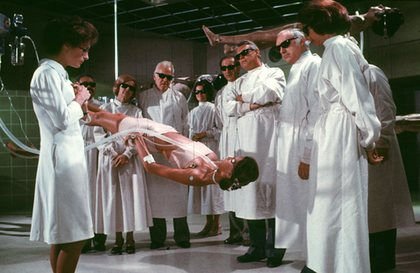Peter Thiel wants to live forever, but the odds are against him. I mean, if you were absolutely sure there were WMDs in Iraq and that Donald Trump would be a great President, you might die right this minute of embarrassment, right? The billionaire investor is safe in this regard, however, since he possesses no shame or self-awareness. Still, he could get cancer or something, so like a lot of deep pockets in Silicon Valley, he’s pouring money into the pursuit of eternal life.
From monkey glands to blood transfusions to all manners of elixirs, complete quacks have been selling forever, well, forever. Silicon Valley of the new millennium sees itself as a more serious player in the field, and its CEOs and VIPs have purchased instant credibility, collecting those with advanced degrees and impressive credentials. Still, something feels a little crooked about it all despite the sincerity.
The extravagant overpromising certainly doesn’t help. Gerontologist Aubrey de Grey is as much a true believer as anyone, his intense quest for immortality so fervent it leads him to sometimes make proclamations far too bold: In 2004, the scientist said, “The first person to live to 1,000 might be 60 already.” That line has not aged well.
The Immortality Industrial Complex will not ultimately make us live eternally, but there will likely be benefits to the research produced by the sector. We might get more bang for the buck if these folks focused on incremental improvements rather than moonshots, sure, but the fortunes funding the search for a “permanent cure” wouldn’t be available were it not for the lure of eternity to entice those with bottomless stock options. The blessing is mixed.
In his New Yorker article “Silicon Valley’s Quest to Live Forever,” Tad Friend approaches the immortalists working under this anti-death directive with his usual mixture of skepticism, sly humor and insight. His reporting suggests that even the most bleeding-edge labs, endeavoring to perfect computer-designed drugs and gene therapies, are still operating largely in the dark. “Super muscularity, ultra-endurance, super radiation-resistance” aren’t theoretically impossible, but we’ll likely have to wait a good, long while for such a biotech revolution.
An exerpt:
For those frustrated by the stately progress of research up the animal chain, from worms to flies to mice to dogs to monkeys, speculative treatments abound. In Monterey, California, a clinic will give you young plasma for eight thousand dollars a pop—but you have no idea what it’s doing to you. Peter Nygård, a leonine seventy-five-year-old Finnish-Canadian clothing designer who got rich making women look slim in modestly priced pants, has had injections with stem cells derived from his DNA. He believes that the process has reversed his aging. In an interview a few years ago, he proclaimed, “I’m the only guy in the world today who has me, in a petri dish, before I was born.”
While [microbiologist Brian] Hanley has a tinkerer’s mentality—there’s a hyperbaric chamber stuffed behind his couch—he’s a dedicated researcher. Since the F.D.A. requires an authorization for any new tests on humans, he began trying therapies on himself. He’d read the literature on self-experimentation, and tallied the results: eight deaths (including that of the blood-transfusing Alexander Bogdanov), and ten Nobel Prizes. Coin toss.
Hanley acknowledged that his research had a few basic problems as a template for reshaping life spans. First, a sample size of one; second, a therapeutic method whose results may not last; third, a gene whose effects seem to be regenerative rather than transformative. In order to comprehensively reprogram ourselves, we’d want to insert corrective genes into a virus that would disperse them throughout the body, but doing so could alarm the immune system.
The advent of CRISPR a gene-editing tool, has given researchers confidence that we’re on the verge of the gene-therapy era. George Church and his Harvard postdocs have culled forty-five promising gene variants, not only from “super centenarians”—humans who’ve lived to a hundred and ten—but also from yeast, worms, flies, and long-lived animals. Yet Church noted that even identifying longevity genes is immensely difficult: “The problem is that the bowhead whale or the capuchin monkey or the naked mole rat, species that live a lot longer than their close relatives, aren’t that close, genetically, to those relatives—a distance of tens of millions of genetic base pairs.” The molecular geneticist Jan Vijg said, “You can’t just copy a single mechanism from the tortoise,” which can live nearly two hundred years. “We’d have to turn our genome over to the tortoise—and then we’d be a tortoise.”
Becoming part tortoise wouldn’t necessarily alarm Brian Hanley. If we can only find the right genes and make their viral transmission safe, he declared, “we can enable human transformations that would rival Marvel Comics. Super muscularity, ultra-endurance, super radiation-resistance. You could have people living on the moons of Jupiter who’d be modified in this way, and they could physically harvest energy from the gamma rays they were exposed to.”•
Tags: Brian Hanley, Tad Friend

